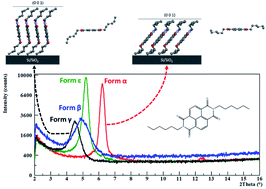On the crystal forms of NDI-C6: annealing and deposition procedures to access elusive polymorphs†
Abstract
NDI-C6 has been extensively studied for its semiconducting properties and its processability. It is known to have several polymorphs and a high thermal expansion. Here we report the full thermal characterization of NDI-C6 by combining differential scanning calorimetry, variable temperature X-ray powder diffraction, and hot stage microscopy, which revealed two different thermal behaviours depending on the annealing process. The ranking of stability was determined by the temperature and energy involved in the transitions: Form α is stable from RT up to 175 °C, Form β is metastable at all temperatures, Form γ is stable in the range 175–178 °C, and Form δ in the range 178–207 °C followed by the melt at 207 °C. We determined the crystal structure of Form γ at 54 °C from powder. The analysis of the thermal expansion principal axis shows that Form α and Form γ possess negative thermal expansion (X1) and massive positive thermal expansion (X3) which are correlated to the thermal behaviour observed. We were able to isolate pure Form α, Form β, and Form γ in thin films and we found a new metastable form, called Form ε, by spin coating deposition of a toluene solution of NDI-C6 on Si/SiO2 substrates.

- This article is part of the themed collection: Understanding Crystallisation


 Please wait while we load your content...
Please wait while we load your content...